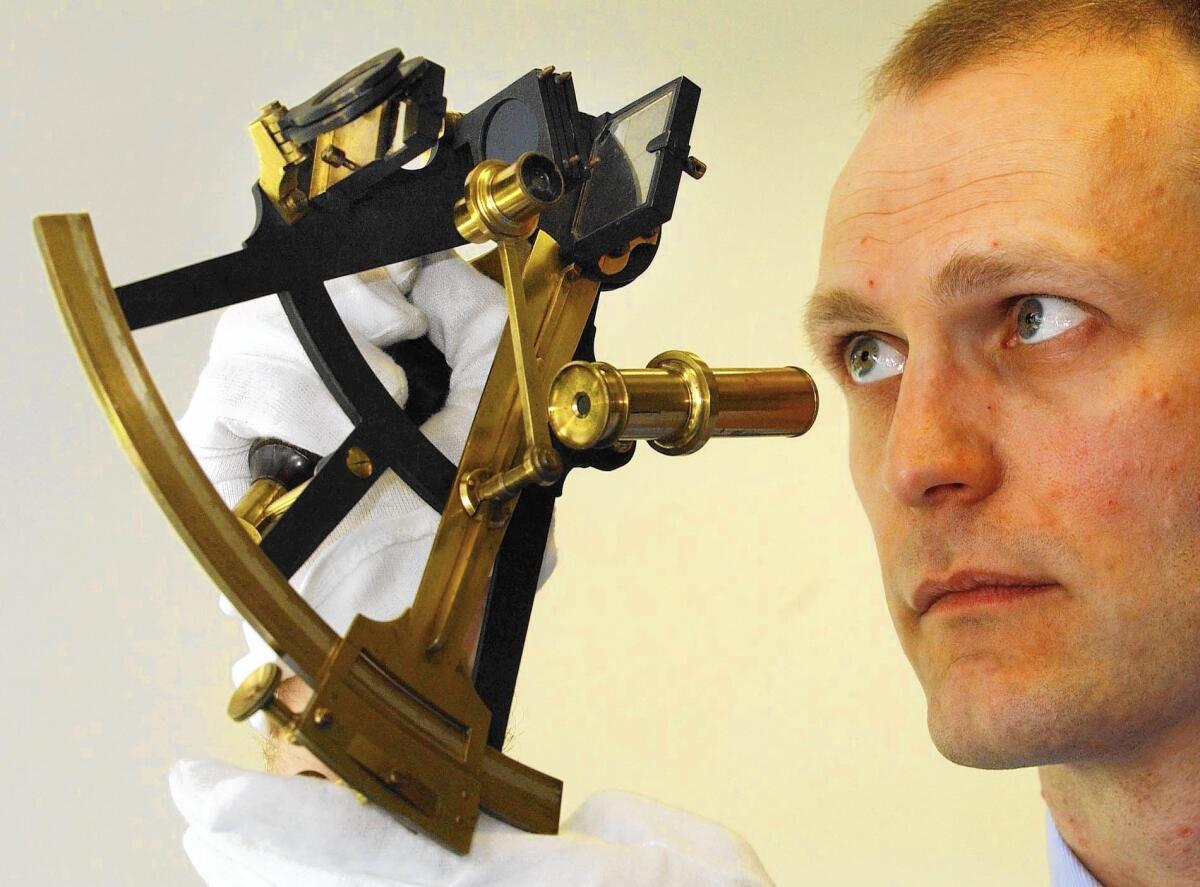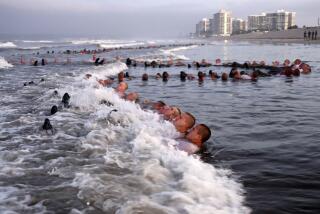In the era of GPS, Naval Academy revives celestial navigation

Celestial navigation involves mastery of the sextant, similar to this one that belonged to Charles Darwin. The U.S. Naval Academy is reviving its program teaching the navigational technique.
Reporting ANNAPOLIS, Md. — The same techniques guided ancient Polynesians in the open Pacific and oriented astronauts when Apollo 12 was disabled by lightning — the techniques of celestial navigation.
A glimmer of the old lore has returned to the Naval Academy.
Officials reinstated brief lessons in celestial navigation this year, nearly two decades after the full class was determined outdated and cut from the curriculum. That decision, in the late 1990s, made national news and caused a stir among the old guard of navigators.
Maritime nostalgia, however, isn’t behind the return.
Rather, it’s the escalating threat of cyberattacks that has led the Navy to dust off its tools to measure the angles of stars.
After all, you can’t hack a sextant.
“We went away from celestial navigation because computers are great,” said Lt. Cmdr. Ryan Rogers, the deputy chairman of the academy’s department of seamanship and navigation. “The problem is,” he added, “there’s no backup.”
Among the fleet, the Navy ended all training in celestial navigation in 2006, said Lt. Cmdr. Kate Meadows, a Navy spokeswoman. Then officers’ training returned in 2011 for ship navigators, she said. And officials are now rebuilding the program for enlisted ranks; it’s expected to begin next fall.
At Annapolis, midshipmen studied celestial navigation for more than a century, until 1998. So what happened?
In the 1990s, airmen launched two dozen satellites nearly 13,000 miles above Earth. By 1995, this network, the Global Positioning System, could pinpoint your location within feet.
“The perceived need for sextants was taken away,” said Peter Trogdon, president of Weems & Plath in Eastport, Md.
The company has sold sextants, and other nautical instruments, since it was founded in 1928 by Naval Academy navigation instructor Capt. Philip Van Horn Weems. He taught Charles Lindbergh navigation during the pioneer days of aviation.
According to Trogdon, sales of sextants plunged after GPS. “There’s only a few thousand sold a year,” he said. A lightning strike to a ship’s mast could disable GPS receivers. “Most of those are sold to yachtsmen [who] want to have a backup.”
But compared with GPS, celestial navigation isn’t exact. A skilled celestial navigator may calculate locations to within 1.5 miles, Rogers said.
Still, a world without GPS isn’t too remote a possibility for retired Navy Capt. Terry Carraway of Silver Spring, Md. He formed the nonprofit Navigation Foundation in the early 1980s to sustain proficiencies in celestial navigation. That organization peaked with more than 500 navigators, he said.
“In the event that we had to go into a national emergency, we would probably have to shut the GPS down because it can be used by potential enemies,” he said.
The foundation disbanded in 2002.
“The old celestial navigators all passed away,” said Carraway, 88.
Cadets at the U.S. Coast Guard Academy in New London, Conn., also used to have a course devoted entirely to celestial navigation. It ended about 10 years ago, said David Santos, the academy spokesman.
Some instruction remains in theories of celestial navigation, Santos said. Also, cadets use a sextant aboard the tall ship Eagle.
Instructors at the U.S. Merchant Marine Academy, in Kings Point, N.Y., have continuously taught celestial navigation, said Benjamin Benson, the spokesman for that academy. Instructor Capt. Timothy Tisch shared materials to help the Naval Academy rebuild its program.
In Annapolis, celestial navigation instruction ended loudly. As the Capital newspaper in Annapolis reported in June 1998:
“First came the old salts, who fear the military school will no longer produce ‘real’ sailors. Knowing how to navigate by the stars, they say, is the mark of a mariner. Then came the profit-seekers, who asked if they could inherit the academy’s $1,500 sextants. Such devices, inquirers said, would be a nice addition to their museum, a nice mantle piece, or of some use out on the yacht.” (The academy still has its sextants, Rogers said.)
The decision came after months of discussion that began with a 1996 curriculum review. That review came partly in response to a cheating scandal in the early 1990s that ended with 24 midshipmen expelled.
The review panel decided the required sophomore course on navigating by stars was outdated. The academy superintendent at the time, Adm. Charles Larson, after consulting with ship commanders, cut the course and added lessons on computer navigation. Midshipmen were relieved.
But now celestial navigation is back, and that’s welcome news to maritime enthusiasts.
“Fantastic,” said Trogdon of Weems & Plath. “How cool is it to go back to the ancestral technique?”
More to Read
Sign up for Essential California
The most important California stories and recommendations in your inbox every morning.
You may occasionally receive promotional content from the Los Angeles Times.









